On Friday September 24, Tinna Hallgrimsdottir will be in front of the Althing, the Parliament, with hundreds of other young people. Like every week or almost for three years, the 26-year-old student will demonstrate for action against global warming, the international movement launched by the Swedish Greta Thunberg, in 2019. “But this Friday is very special because, the next day, Icelanders will go to the polls”, she confides, in her small apartment not far from Parliament.
The Icelandic association of young environmentalists (Ungir umhverfissinnar), of which she is a member, noted the proposals of each party according to environmental criteria. Published in early September, their assessment had such a media response that it prompted some candidates to review their copy. “We are the first to be surprised, says Finnur Ricart Andrason, 19, also a member of the association. But above all, we hope that our notes will have helped voters navigate the multitude of programs. “
Many parties in contention
This will not be too much: a few days before the legislative elections organized on Saturday September 25, many Icelanders still confided that they will undoubtedly make their choice at the last minute. “Rarely have voters been so indecisive in the home stretch”, observes Thordur Snær Juliusson, editor-in-chief of the online investigative magazine Kjarninn, nestled on Reykjavik harbor. “It is the first time in the history of a country that so many parties have come forward and, above all, have a chance to enter Parliament as well as the government”, adds Hulda Thorisdottir, professor of political science at the University of Iceland.
Among the dozens of existing parties – not all of them present candidates – eight or nine should in fact share the 63 deputy seats. From left to right, with all the nuances of center, the differences between their projects are sometimes subtle. According to the latest polls, the Independence Party (conservative right) would win around 21% of the ballots – which would be its worst score ever – while the others would evolve between 6% and 12%.
This means that the coalition in power since 2017, a strange team between the Independence Party, the Green and Left Movement (environmental left) and the centrists of the Progress Party, will undoubtedly find it difficult to maintain its majority. . A fourth party may be needed to form a new government. Or even a fifth. “The fragmentation of the political scene that began after the 2008 financial crisis is reaching new heights”, summarizes Eva H. Önnudottir, from the University of Iceland.
You have 53.33% of this article to read. The rest is for subscribers only.
